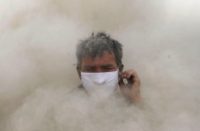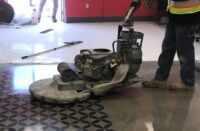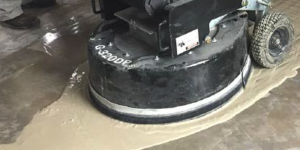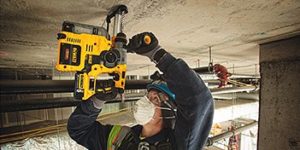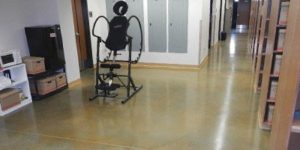This column covers a topic that could determine the sustainability of your business: indoor air quality both during and after construction. Although air quality for your workers and your clients has always been your responsibility, new federal rules are making it essential.
The new requirement you need to know about is the Environmental Protection Agency’s Renovation, Repair and Painting Rule, which tackles the problem of lead dust. If you ever do work in homes, child care centers or schools that were built prior to 1978, you need to understand the RRP Rule, which became effective April 22, 2010. The RRP Rule imposes strict lead-safe work practice requirements on contractors. Failing to comply with this new rule is really not an option if you want to stay in business. The EPA can fine you up to $32,500 per violation per day.
Most concrete work, even in older homes, doesn’t involve paint removal. If you’re sure you will never be called upon to remove or disturb lead paint, then move on to the second part of this article, which discusses silica dust control. But if there’s a chance you will get work requiring lead-safe practices – for example, grinding or cutting a surface with lead-based paint on it – do what you can to learn the requirements or else face the prospects of EPA fines and owner lawsuits.
 Getting the lead out
Getting the lead out
Lead has been a priority for the EPA for more than 30 years. Lead poisoning, especially of children, results in memory loss, learning disabilities and diminished motor skills. The most common way children are exposed to lead is from lead paint, especially during renovation work. Whether you believe this is a real risk or not is irrelevant – the law will show little mercy on this issue.
Lead paint was banned in 1978 but obviously the problem didn’t go away. The U.S. Department of Housing and Urban Development estimates that there are about 38 million homes in the United States that contain lead-based paint. If a contractor disturbs more than 6 square feet of lead paint, the RRP Rule takes effect.
Some of the requirements of the RRP Rule are:
- Contracting companies must be certified by the EPA. This requires filling out a two-page application and paying a fee of $300.
- You must have an RRP-certified worker on each job where lead-safe work practices are required. To get certified, the person needs to take an eight-hour training class from an EPA-approved trainer. You can find a link to information about these training classes on the EPA’s RRP Web site. An unscientific survey of these classes shows that the cost is around $200.
- You must test any painted surfaces before disturbing them, although there are some exceptions. The best approach is to test the paint in any home built before 1978 with an EPA-approved test kit.
- You must follow lead-safe work practices when the paint contains lead.
- You must provide the owner with a Renovate Right brochure, which can be downloaded at the EPA’s Web site. And you must verify that the owner received this and understands the provisions – in writing is best.
Lead-safe work practices include using tools with HEPA-filtered vacuums, closing off all potential escape routes for dust, and carefully cleaning the entire area at the end of the job. Even your workers’ clothing must be cleaned so that they don’t take lead-tainted dust home with them. There is currently an “opt-out” provision in the rule that allows an owner to state that no young children or pregnant women will be exposed to the dust, although the EPA is proposing to remove that exemption. EPA estimates that the cost of all this ranges from $8 to $167 per job – that obviously depends on how many such jobs you get. But don’t get caught unawares by this new rule. Get the EPA’s compliance guide for contractors (via the link at the end of this story) and read it carefully prior to disturbing any painted surfaces in older buildings.
Crystalline silica dust-up
“Dust” is any small particles less than 500 micrometers in diameter. Crystalline silica is quartz. Nearly all concrete contains quartz from the sand in the mix. The dust that is of most concern to contractors is respirable dust, smaller than 5 micrometers. “Respirable” means the dust is small enough to be breathed into the lungs. Breathing respirable crystalline silica dust, which is generated by sawing, drilling or grinding concrete, can cause silicosis, in which the dust creates scar tissue in the lungs, reducing breathing capacity and increasing susceptibility to lung infections. The Centers for Disease Control & Prevention estimates that about 16,000 people died as a result of silicosis between 1968 and 2002, and many of those deaths were construction-related.
The Occupational Safety and Health Administration (OSHA) has established Permissible Exposure Limits for airborne crystalline silica. While measuring dust levels is possible with the right equipment, it’s safe to say that if you can see dust in the air then the level is too high to be breathing it. Although respirable dust is too small to see, it is nearly always accompanied by larger visible dust.
The three ways to keep your workers safe from airborne crystalline silica dust are to prevent the dust from becoming airborne (dust suppression), keep workers away from dusty areas, or use respirators. The best, and the OSHA-preferred method, is to prevent the dust from getting into the air in the first place. These “engineered controls” are vacuum systems or wet-cutting or grinding methods. There are some good vacuum systems available today, but we all know that having such a system handy when you’re running around a job site with a cutoff saw is inconvenient. That typically means the next best approach, a respirator.
Paper dust masks cannot filter out respirable crystalline silica dust. It’s that simple. Relying on dust masks doesn’t protect your workers and doesn’t protect your company if someone ends up with silicosis. Even good respirators can be ineffective with workers who have beards or mustaches. It is the employer’s responsibility to make sure workers are protected. Half- or full-mask respirators with replaceable N95 filters are the minimum protection required and you should test them with your workers to assure good fits.
Those who are nearby and inhale only casual dust will seldom breathe in enough dust to create a real problem. But as you are only too aware, an owner’s perception can be more important than reality. Controlling dust at the source, especially on interior projects, is the best approach.
More information about lead paint issues
EPA lead-based paint compliance guide:
www.epa.gov/lead/pubs/sbcomplianceguide.pdf
EPA Renovate Right brochure:
www.epa.gov/lead/pubs/renovaterightbrochure.pdf
HUD information about lead-based paint: portal.hud.gov/portal/page/portal/HUD/press/press_releases_media_advisories/2010/HUDNo.10-082
EPA RRP training classes:
www.epa.gov/lead/pubs/renovation.htm
More information on silica dust control
OSHA:
www.osha.gov/Publications/3362silica-exposures.pdf
The International Concrete Repair Institute (ICRI): www.icri.org/PUBLICATIONS/2009/PDFs/septoct09/CRBSeptOct09_Silica.pdf
American Society of Concrete Contractors: www.ascconline.org/SafetyBulletins/SBSilicaDustExposureWebSC.pdf
Centers for Disease Control & Prevention/NIOSH:
www.cdc.gov/niosh/topics/silica/default.html
www.cdc.gov/mmwr

